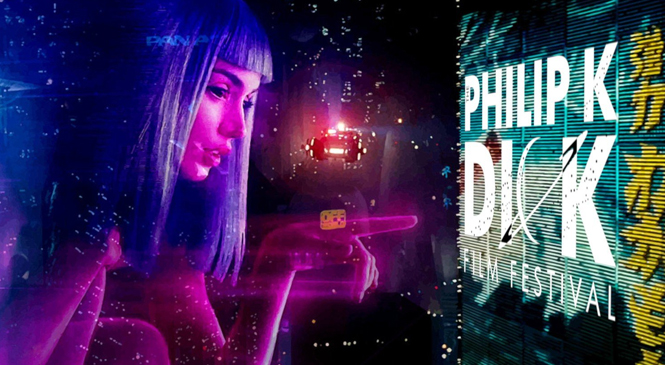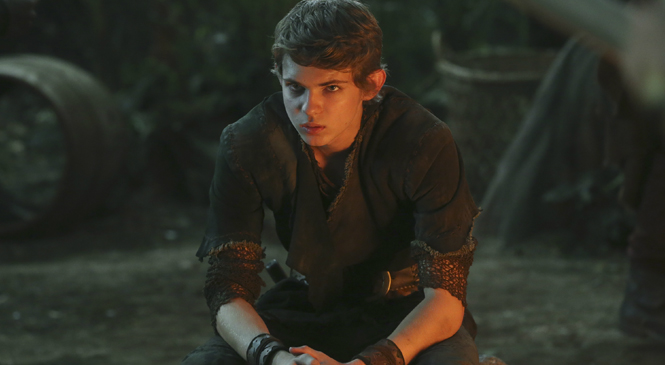One Day at the 2024 Philip K Dick Film Festival

This year, the Philip K Dick Film Festival ran from Wednesday, April fourth through Sunday, April seventh. Screenings took place in two locations, the Producers Club Cinemas on Manhattan, and the Museum of the Moving Image (MOMI), in Queens.
The festival strives to promote original or adapted material inspired by Philip K Dick, whose writing, while generally considered science-fiction, is profoundly inspired by metaphysical and philosophical ideas.
We only attended the Sunday screening at MOMI, and will discuss the shorts and films from that day.
The first segment of the Sunday festival at MOMI was the shorts. The theme for Sunday’s showing was “Humanity Prevails”.
As opposed to a whole movie, shorts make some assumptive propositions that the audience needs to accept for the short to succeed. As one viewer commented during the Q&A following the shorts screening, “The short tells a story but never explains how the characters got to that point.” Generally, a movie tells a story by starting at the beginning and then demonstrating how this changes. A short, on the other hand, has limited its storytelling to a singular incident. The general expectation is that a character begins an experience in a place, only to return to that same place shortly thereafter, somehow changed. Shorts are exciting, tight storytelling that can feel like a filling meal offered in a single bite.
Suppressus: 19 minutes. Directed by Grant Jones.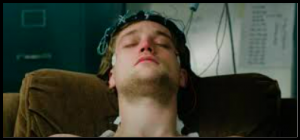
Summary: A man is experiencing an experimental type of therapy, where a computer system stimulates the patient to relive traumatic experiences that they have since blocked out with the purpose of allowing them to heal.
This short was very raw, almost claustrophobic as three men—two technicians and one patient—engage in a cramped room, surrounded by wires and computer parts, none of which make any sense or need to. The interplay between the characters expresses doubt and frustration, growing to confidence and concern, and finally achieving success as the patient relives a childhood memory. Only, an error causes him to experience it as an adult, and his father—who was young when the experience occurred—appears as an elderly man.
Reverie: 11 minutes. Directed by Kerri Horan.
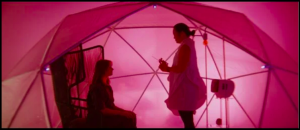 Summary: A woman is experiencing time-travel therapy. She has only a few minutes—and three attempts—to go back to a specific moment in her life to either re-experience or change what occurred.
Summary: A woman is experiencing time-travel therapy. She has only a few minutes—and three attempts—to go back to a specific moment in her life to either re-experience or change what occurred.
Coming literally on the heels of the previous short, also about a therapy involving re-experiencing past moments, Reverie did a fantastic job of differentiating itself. With a cast of three and two settings, it does well with a very limited budget as Imogen, now thirty, seeks to go back to better understand her teenage self. It becomes clear, however, that young Imogen wants nothing to do with the older woman who is trying to give her advice. With two failed attempts, Imogen is learning that to connect to her younger self maybe shouldn’t involve telling her what to do.
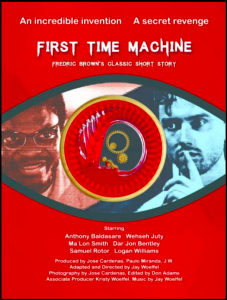 First Time Machine: 18 minutes. Directed by Jay Woelfel
First Time Machine: 18 minutes. Directed by Jay Woelfel
Summary: When a black scientist creates the first time machine, it is stolen by his white friend, who uses it to go back in time to kill his own grandfather, resulting in the scientist inventing a different type of machine and having different desires for its use.
This short told two stories, the first being about a scientist who, when his invention, a time machine, is stolen by a friend who subsequently is never born—because of the time machine—ends up inventing something completely different. The friend, a victim of generational trauma, goes back to murder his own grandfather because of the pain he perpetrated on his whole family. The second story the short tells is about the interaction of race. A black scientist has his invention stolen by a white man. Instead of using it to kill Hitler or save Lincoln, this man goes back in time and murders his own grandfather, who was a horrible, evil person. The scientist, now living in a timeline when his white friend was never born, instead invents a device—similar to the time machine—that cures cancer. Except, it only works on black people.
While interesting in premise and morality, this short spent too much of its time explaining the workings of its machines rather than focusing more on the machine’s impact on the people. This diminished the story and the weight of the messages that were of far greater importance.
Demon Box: 14 minutes. Directed by Sean Wainsteim
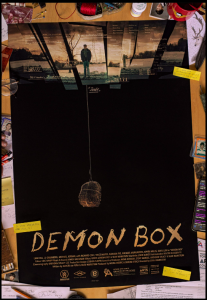 Summary: Following several festival rejections, the director of the short film, Demon Box, narrates a documentary of the creation and failings of the film, which was about his childhood fear of Nazis, caused by the trauma of listening to his grandfather’s stories about his experience in a concentration camp, and how his grandfather gave him a “demon box” to capture his imaginary Nazis.
Summary: Following several festival rejections, the director of the short film, Demon Box, narrates a documentary of the creation and failings of the film, which was about his childhood fear of Nazis, caused by the trauma of listening to his grandfather’s stories about his experience in a concentration camp, and how his grandfather gave him a “demon box” to capture his imaginary Nazis.
Wow. Looking at that summary you might be tempted to think this would be the biggest downer of a movie. Instead, we’re presented with a metaphysical doozie. The narration of this festival failure is hysterical. But, rather than making laughter that mocks the tragedy behind the short, it turns it all into a bittersweet soup for the soul. In the end, Demon Box is about how trauma is passed down, generation to generation, and the recognition by the grandson that his fear the experience caused him isn’t weakness. Now a father himself, the grandson understands it is his responsibility to explain to his child what the Nazis did to his grandfather, all the while contemplating if there is any way to do so while also protecting his child.
While this film did not win any festival awards, it was—in a tight field—my favorite. Both Demon Box and The First Time Machine speak to the pain caused by generational trauma. It is the way they each approach the subject from such different directions that makes their statements so fascinating to compare.
Human Resources: 10 minutes. Directed by Jay Ness.
Summary: A woman is responsible for the final day of training for a customer service android. The final lesson she must teach it is empathy and connection.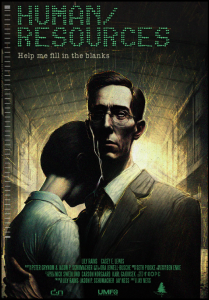
A stunning story told very concisely. A story of a trainer and her trainee. How to teach empathy and connection is a contrived situation. When teaching emotion becomes a corporate position, how does the employee not lose their humanity? It is only once the trainee passes and is replaced by the next trainee that the viewer can be certain which of the two individuals is not the human.
Human Resources was our next favorite for the day. Knowing which character was supposed to be human and which was supposed to be the android trainee only made for the surprise flip in roles more impactful as the human trainer behaves like the corporate drone and the android trainee seeks to make a connection beyond the expectation of their role.
Autopilot: 17 minutes. Directed by Jennifer Zhang.
Summary: A lone pilot returning to Earth finds her “virtual companion” is no longer bound by his programming.
A visually 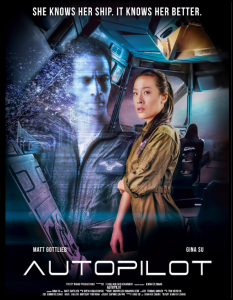 stunning thriller. Filmed on the last remaining set from Firefly, Autopilot made a fantastic companion piece to Human Resources, where the interactions between a human and an artificial intelligence blur the lines as to who—or what—is human.
stunning thriller. Filmed on the last remaining set from Firefly, Autopilot made a fantastic companion piece to Human Resources, where the interactions between a human and an artificial intelligence blur the lines as to who—or what—is human.
Each morning, Diana, the pilot, awakens alone to solo-pilot the earthbound ship. She turns on and off Ovid, her virtual companion, who offers her brief company at the start and end of each day. When Ovid begins malfunctioning, Diana is terrified that her virtual companion is trying to kill her. In the end, it is Diana learns that she is in fact the android and when she turns Ovid on and off, it is actually her own programming that briefly allows her to see the human she is ferrying home.
We were thrilled to hear that Autopilot was already put into pre-production as a feature film. A close third with Human Resources, these two shorts do a phenomenal job of questioning the humanity that makes us human.
Also at the Sunday showing at MOMI were two feature films:
Quantum Suicide: 87 minutes. Directed by Gerrit Van Woudenberg. Festival winner: Best Science Fiction Feature.
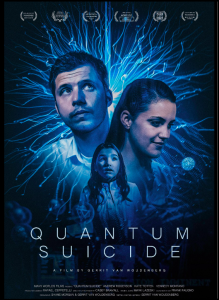
Summary: A physicist, working in his home-built particle accelerator, believes that the final step to proving he has found solution to the grand unification theory has one final test to make: quantum suicide.
Quantum suicide is a complicated thought experiment. Similar to Schrödinger’s cat, which states that if you seal a cat in a box with something that will eventually kill it, you cannot know if the cat is alive or dead until you open the box. Meaning that until the box is opened, the cat is both alive and dead. It’s a metaphor for particle decay, in which until an observation is made, one can never know the state, and so the particle remains in a dual state until observed. In Quantum Suicide, the “victim” becomes the cat in the box. But because they are their own observer, they always survive. For everyone else, they die. They exist in both states simultaneously.
While a disturbing and interesting premise, Quantum Suicide felt more like a short that was stretched to be a full-length feature. Putting aside, of course, that a scientist, Cayman, has built a particle accelerator in their garage, the film does offer a very interesting supposition of dual states of existence. It begins with the act the movie is named for, and then continues as though looping back to tell the story about how the scientist got there. I came to think that the notion of quantum suicide, where the victim can never die except to everyone else, was actually being demonstrated for us. Killed in the opening scene, Cayman is experiencing a version of his life where he survived, all the while everyone around him is slowly being drawn to the discovery of his death.
Alone Together: 94 minutes. Directed by William Kresch. Festival Winner: Best Supernatural Feature.
Summary: At the height of the pandemic in 2020, a couple in a toxic and abusive relationship escape New York City to a cabin in the woods that once belonged to the husband’s father. The strain of isolation slowly erodes the bonds that kept them together, causing each of them to become more of what they really were all along.
Alone T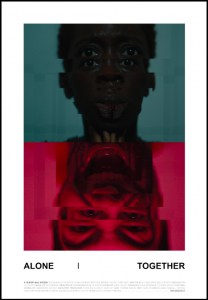 ogether is a brutal and oftentimes disturbing film. As a child, Luke watched his sadomasochistic father commit suicide because he could no longer bear the atrocities he had committed in Vietnam. Now an adult and married to Nassdja, they escape to the cabin to ride out the Covid lockdown of 2020.
ogether is a brutal and oftentimes disturbing film. As a child, Luke watched his sadomasochistic father commit suicide because he could no longer bear the atrocities he had committed in Vietnam. Now an adult and married to Nassdja, they escape to the cabin to ride out the Covid lockdown of 2020.
At the start of the film, Nassdja has a split lip, but it isn’t until later that it becomes obvious that Luke was the one who hurt her. It is with the same subtlety that his controlling and manipulative behaviors slowly bubble to center stage until we cannot escape being aware of how cruel and dangerous he truly is.
Nassdia begins as a broken, frightened woman who, as she becomes more and more aware of how dangerous Luke really is, begins—for the first time—to fight for her life.
While this doesn’t necessarily sound like it would fit into a Philip K Dick festival, it is the addition of the supernatural that does the trick. Luke’s dead father first haunts Nassdja, terrifying her—perhaps even more than Luke does—but eventually becomes like some sort of undead spirit animal to give her the strength to endure as Luke hunts her.
These two films, Quantum Suicide and Alone Together, speak to the duality of the person. In Quantum Suicide, it is whether they are alive or dead. In Alone Together, it is whether they are prey or predator.
Overall, the short selection was my favorite part of Sunday’s festival. The stories were tightly told and thought-provoking. More so, the brilliant curation of the festival allowed a comparison of similar themes between sets of completely unrelated stories. Watching Suppressus and Reverie, First Time Machine and Demon Box, Human Resources and Autopilot, Quantum Suicide and Alone Together, back-to-back demonstrated how vastly different stories can speak to similar themes: trauma, intergenerational trauma, humanity, and the dual nature of humanity. The curation of the festival was absolutely a highlight and made this festival stand out beyond any other festivals we’ve attended.
![]()

